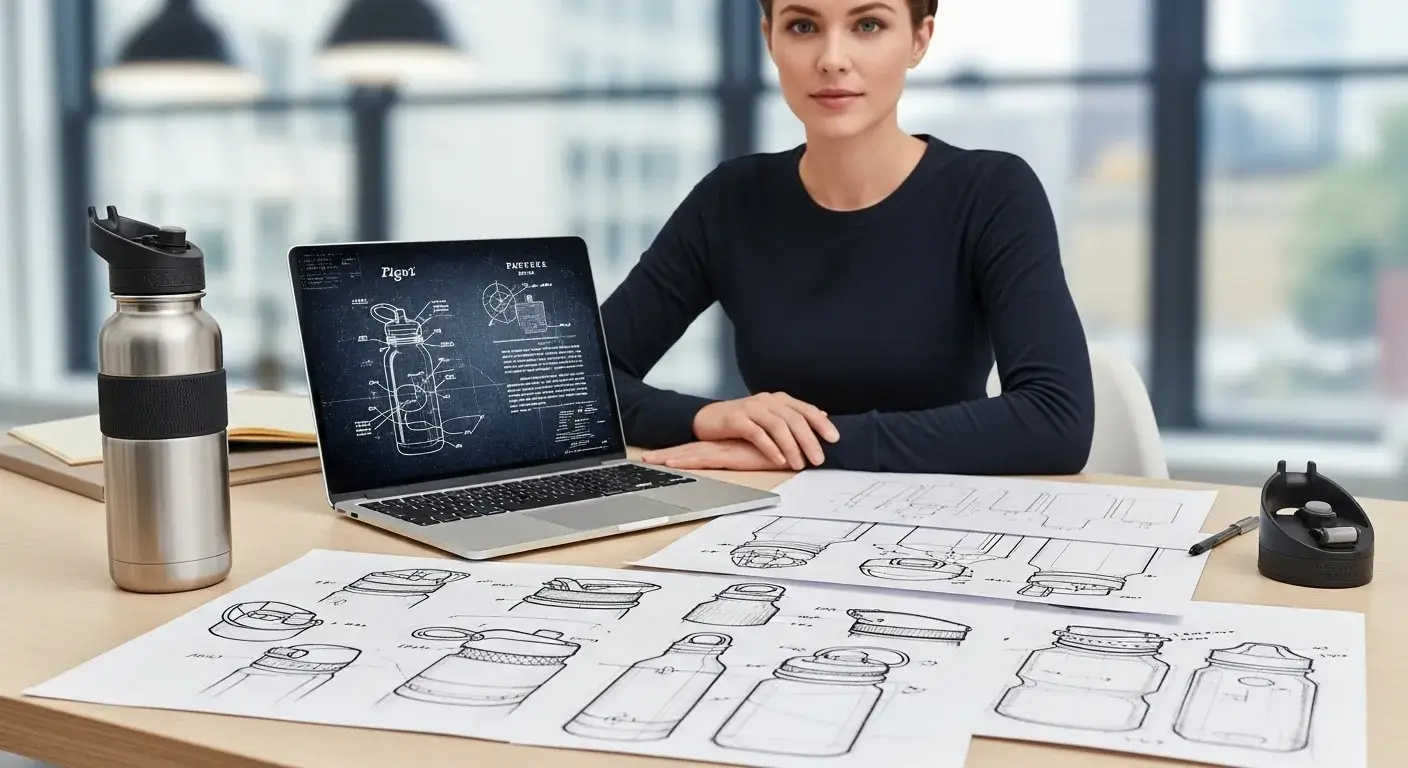
I wanted to ship a new bottle once, but I nearly hit a patent roadblock. I learned the hard way and now I help others avoid that cost.
Patent clearance (FTO) prevents costly lawsuits by checking active patents that could block your product. Early clearance saves money and time.
I will walk you step-by-step through searches, tools, design-arounds, and when to call an attorney.
What Is Patent Infringement in Water Bottle Design, and Why Should You Care?
You may build a great bottle and then get sued. Lawsuits can stop sales and destroy a brand. Learn what counts as infringement and act early.
Patent infringement occurs when you make, use, sell, or import a product1 that practices the claims of a valid patent without permission. For water bottles, patents cover utility features (like valves or insulation) and design elements (ornamental shapes or lid forms).
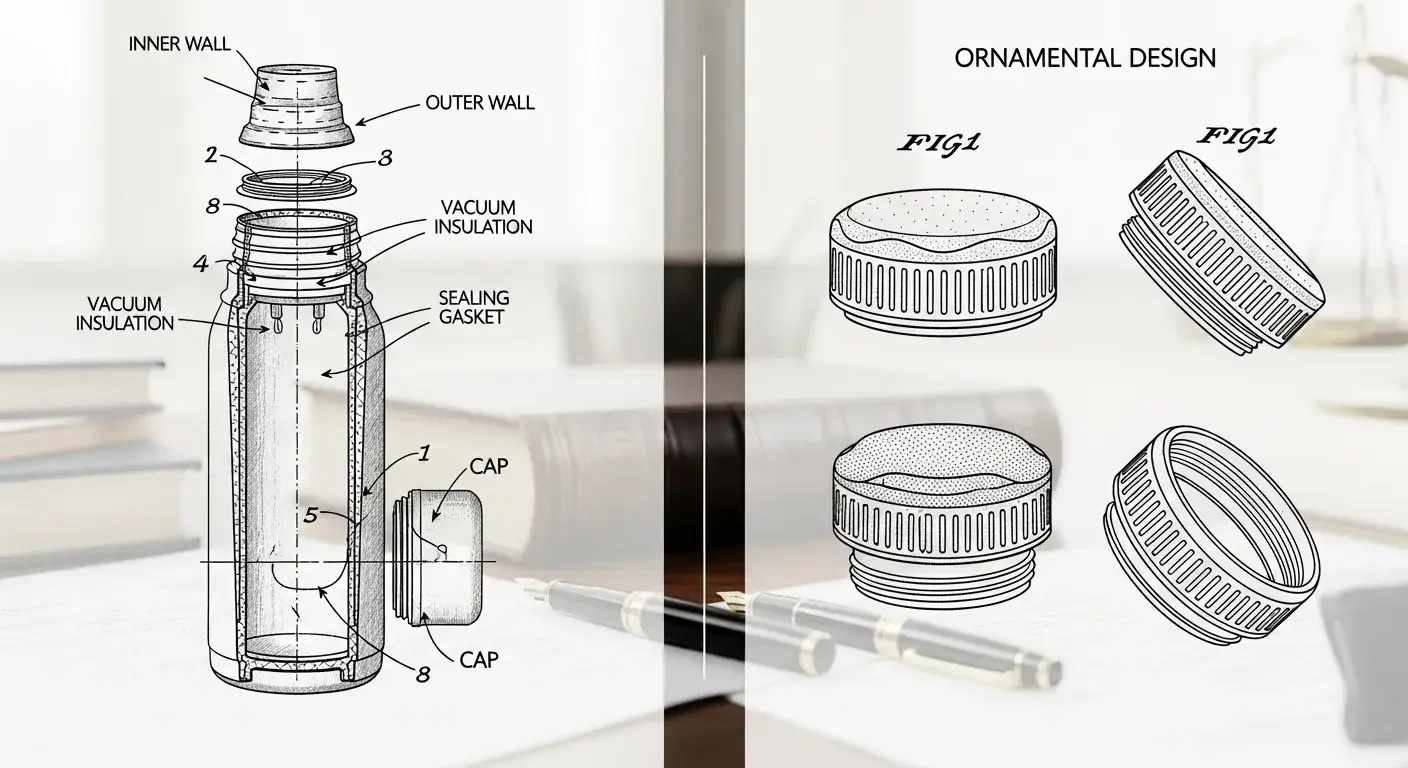
how infringement works and real stakes
How patent rights are structured
- A utility patent2 protects functional features. Example: a vacuum insulation method.
- A design patent2 protects ornamental shape and appearance.
- A claim defines exactly what the patent covers. Claims are what courts use.
Why water bottles are risky
- Drinkware mixes function and appearance. Many makers patent lids, seals, spouts, and shapes.
- I once saw a startup copy a popular flip-lid. The design patent on the lid blocked their launch.
- Trade dress and trademarks can also block designs that look "confusingly similar."
Key risk numbers (practical view)
- Early FTO reduces redesign costs by about 70% versus late discovery.
- Licensing often costs far less than litigating. I helped a client license a lid for $12K rather than fight for $250K.
Quick checklist to spot risk
- Look for similar products with unique lids or closures.
- Check for "design patent" markings on products you copy.
- If a feature is central to your product, flag it for claims review.
Quote: "Patent claims are the map. If your product steps outside the map, you avoid infringement."
I keep a risk table in my projects. I recommend you do the same. It helps you see issues early.
How Do You Perform a Freedom-to-Operate (FTO) Search for Your Water Bottle Concept?
You don't know where to search. An incomplete search misses blocking patents. Use a structured FTO workflow and document it.
An FTO search maps active patents that could block commercialization3 in jurisdictions you target. It focuses on claims, not just titles.
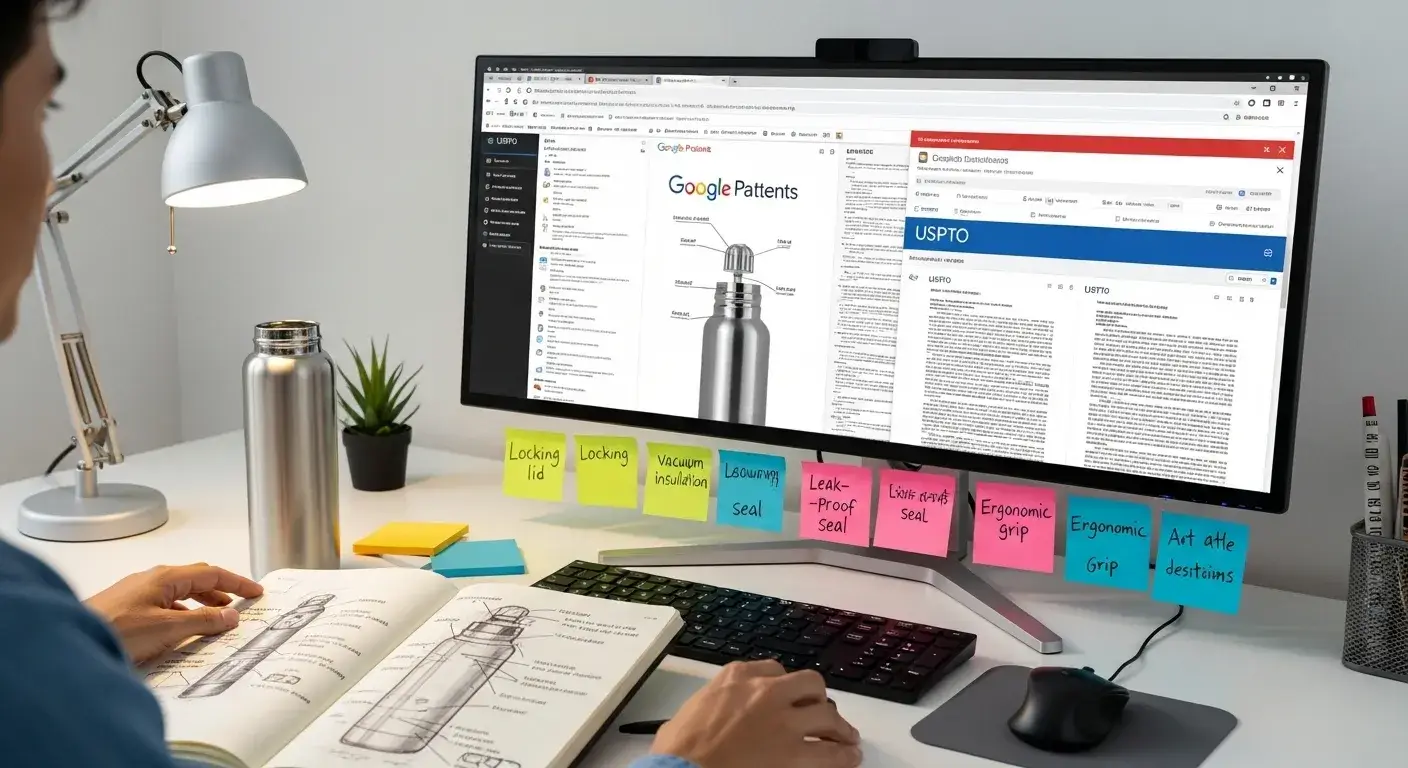
DIY FTO steps and pro shortcuts
Step-by-step FTO workflow I use
- Define product elements. List every part: lid, spout, insulation, sleeve, cap lock.
- Create search keywords. Use function and structure: "vacuum insulated lid locking tab."
- Search patent databases. Start free: Google Patents, USPTO, Espacenet.
- Filter by date and family. Focus on unexpired patents in your markets.
- Read independent claims. If a claim contains every element of your product, flag it.
- Document results and dates. Store screenshots and search strings.
Practical tips I learned
- Search both utility class (e.g., thermal containers) and design patents (ornamental bottle shapes).
- Use images in Google Patents to spot similar shapes quickly.
- Run a second search on variants and synonyms. Patent authors use varied language.
When DIY limits fail
- DIY covers a lot, but not all. Claim construction and equivalents need expert review.
- I hire a patent attorney for an FTO opinion if I plan large orders or serious investment.
FTO table (simple)
| Stage | Task | Outcome |
|---|---|---|
| Define | List elements | Clear scope |
| Search | Databases + images | Candidate patents |
| Analyze | Read claims | Identify blockers |
| Document | Save evidence | Legal record |
| Decide | Proceed/license/avoid | Risk informed choice |
I keep a log of every search. Judges value documented effort if disputes arise. That alone can reduce willful-infringement damages.
What Are the Best Tools and Databases for Spotting Existing Drinkware Patents?
The web is noisy and incomplete. Missing a patent can cost millions. Use a mix of free databases, paid AI tools, and targeted feeds.
Combine free patent databases with modern AI tools and targeted patent alerts for best coverage. Each tool contributes different signals.
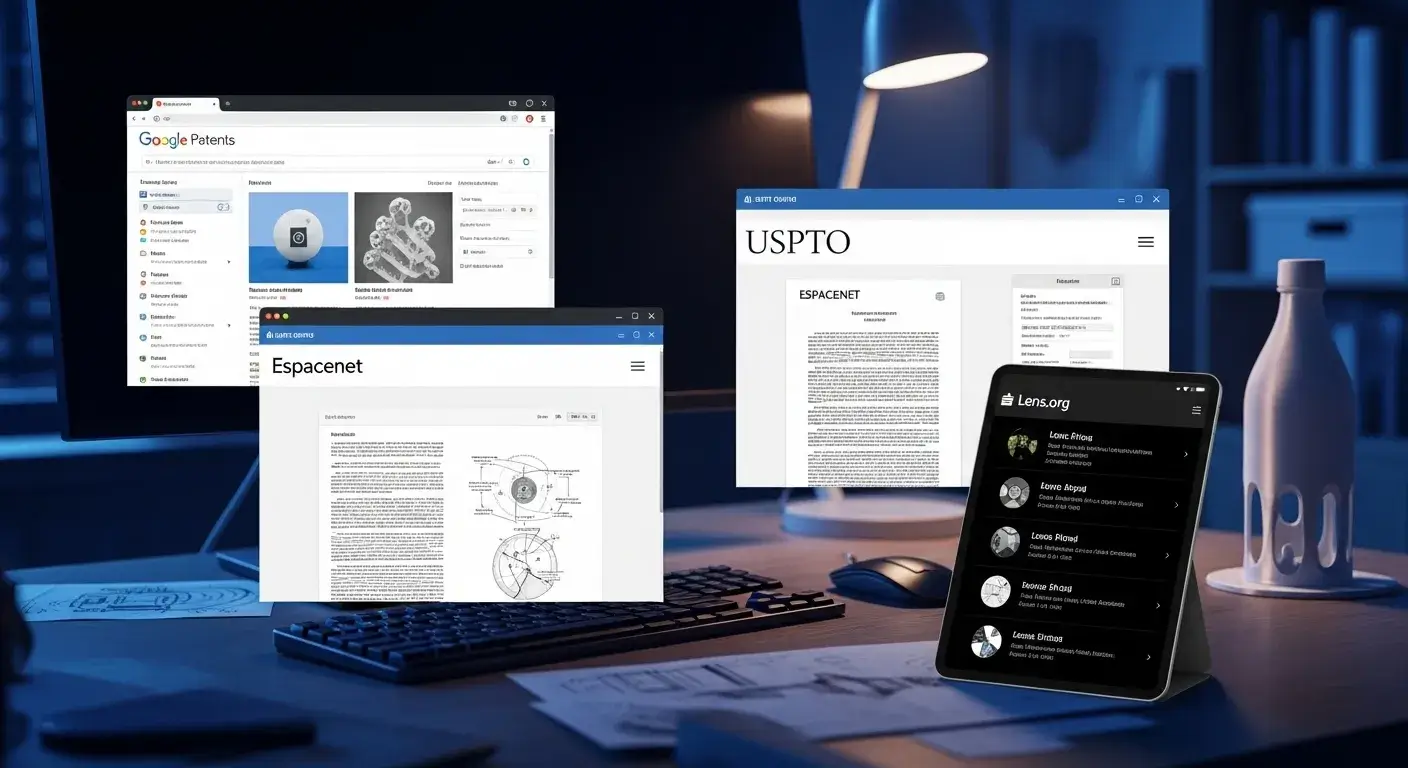
My tool stack and how I use each item
Free tools I trust
- Google Patents4 — Great for image search and global coverage. Use the image viewer for designs.
- USPTO Patent Center — Official US records and prosecution history.
- Espacenet (EPO) — Strong for EU and global families.
Paid and AI tools to level up
- Handheld XRF-like analogy: For patents, AI tools parse meaning. Use Patentext or Solve Intelligence for semantic matches.
- Lens.org — Excellent for alerts and class filters.
- Private databases — For heavy R&D, consider commercial providers with claim clustering.
How I combine tools
- Start with Google Patents for quick image and keyword checks.
- Run Patentext to catch semantic matches missed by keywords.
- Use Lens.org alerts for new filings in classes like A47J (beverage containers).
- Save all hits to a spreadsheet and tag by risk (high/medium/low).
Tool comparison (short)
| Tool | Strength | Best for |
|---|---|---|
| Google Patents | Image + free | Quick visual scanning |
| USPTO | Official data | Claim/legal status |
| Espacenet | Global families | EU/International checks |
| Patentext / Solve | Semantic matches | Catch disguised claims |
| Lens.org | Alerts | Ongoing monitoring |
I set alerts for "flip-lid", "vacuum insulated", and "bottle sleeve". It saved me twice from late surprises.
How Can You Design Around Patents While Keeping Your Water Bottle Innovative?
You like a feature that a patent covers. Small tweaks may still infringe via equivalents. Remove or change key claim elements and create new value.
Design-around is not a percentage change. It is a claim-based strategy: remove or alter at least one essential claim element so your product no longer reads on the claim.
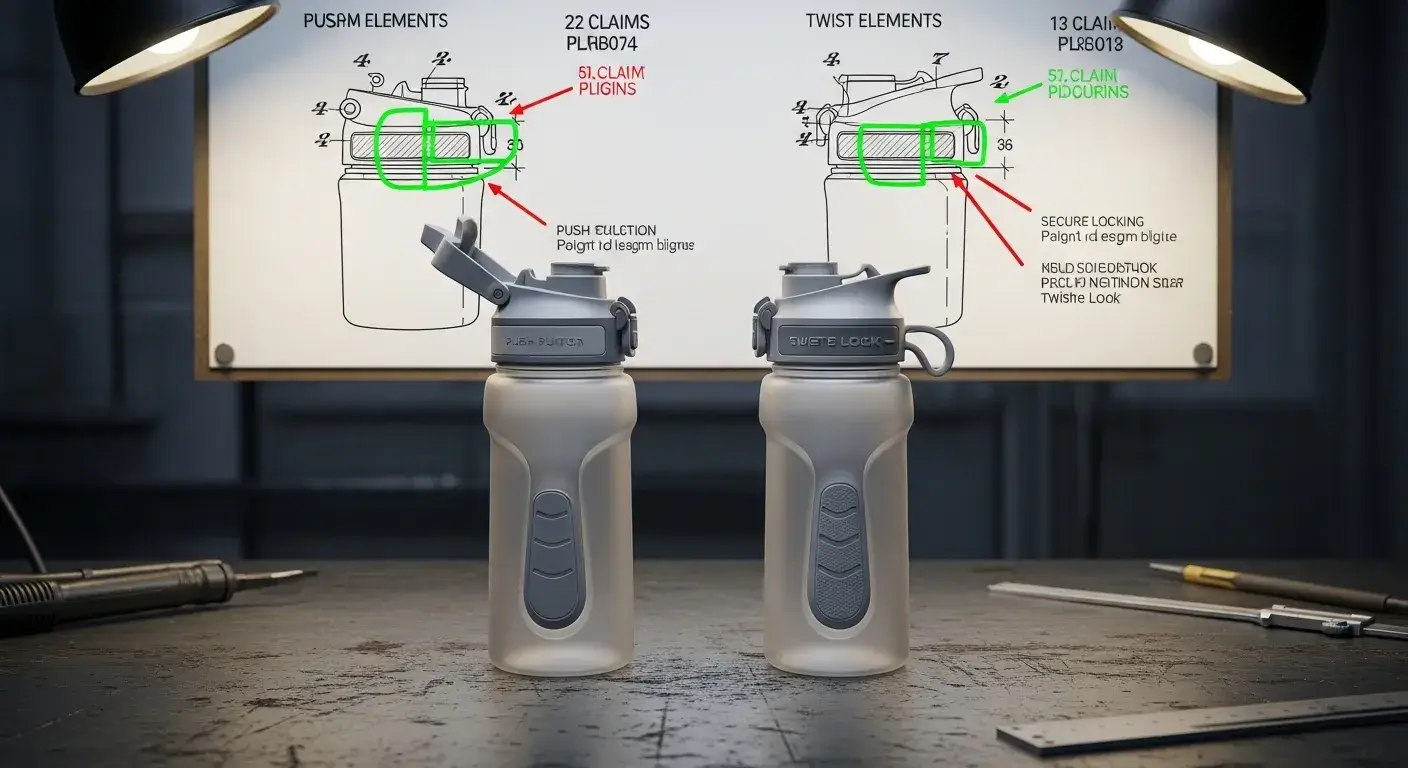
Practical design-around tactics I use
Understand the claim language
- Identify independent claims. These are the broad claims you must avoid.
- Break claims into elements. Ask: does my product literally include each element?
Design-around strategies
- Omit an element. If a claim requires a spring latch, use a twist lock instead.
- Change the mechanism. Replace a patented hinge with a sliding closure that works differently.
- Use a different material or structure. A patent on a specific assembly may not cover a materially different build.
- Add a new feature that creates a distinct trade-off or benefit, making your device non-equivalent.
- File your own patent for the new feature to strengthen position.
Beware the Doctrine of Equivalents (DOE)5
- Courts can find infringement even without literal copying if your change is insubstantial.
- I design changes that alter function, way, or result to reduce DOE risk.
Example table — cap claim vs. design-around
| Patent Claim Element | Typical Design | Design-Around Option |
|---|---|---|
| Hinged flip cap | Single hinge | Rotating rotary cap |
| Integrated straw | Internal straw | External screw-in straw |
| Magnetic seal | Magnet ring | Compression gasket |
I once redesigned a straw lid to use a screw-in external straw. It avoided a pending lid claim and added a new sealing benefit that I patented.
When and Why Consult a Patent Attorney During Water Bottle Development?
You may rely only on DIY searches. Mistakes cost more than counsel. Engage counsel at key milestones for opinions and licensing.
Consult a patent attorney when you hit red-flag patents, before big investments, or when you need an FTO opinion to show good faith.

Timing, costs, and what to expect
When to call an attorney
- After your DIY FTO finds candidate blocking patents.
- Before placing large orders or public launch.
- If you plan to license or buy patents.
- When considering enforcement or defensive actions.
What an attorney delivers
- FTO opinion letter: Legal risk assessment you can use to inform decisions.
- Claim charting: Side-by-side mapping of your product to patent claims.
- Licensing negotiation: Draft and negotiate terms.
- Design advice: Help craft arounds that stand up legally.
Typical costs and ROI
- Hourly rates vary: $300–$600/hr in many markets.
- Fixed FTO opinions can run $2K–$10K depending on scope.
- Compared to $100K+ litigation, this is prudent insurance.
Questions to ask an attorney
- How broad are the claims? Are they likely to be enforced?
- Is licensing cheaper than redesign?
- Can you get a written opinion that reduces willful infringement risk?
I spent $4K on an opinion that saved me from a $200K licensing demand. That cost justified itself many times over.
What Are the Potential Risks and How to Mitigate Them Legally?
You may underestimate post-launch risks. A competitor can sue and stop sales. Combine legal, insurance, and operational defenses.
Mitigate infringement risk by documenting FTO, licensing when needed, buying IP insurance, and monitoring new patents.
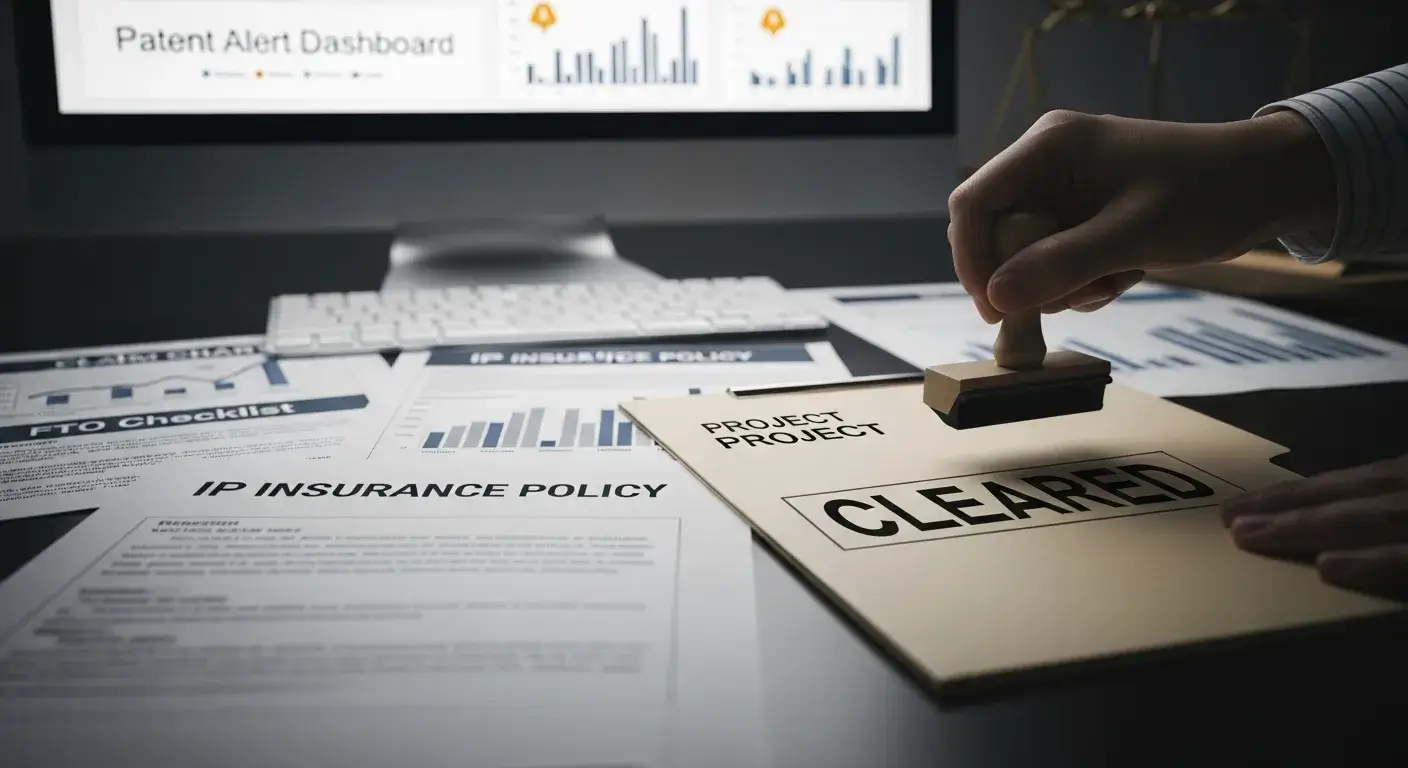
Layered mitigation plan I recommend
Preventive measures
- Thorough FTO before launch and record keeping.
- Design documentation showing independent development.
- File your own patents to create bargaining power.
Operational defenses
- Licensing: Negotiate non-exclusive or limited licenses when cheaper than redesign.
- Insurance: Buy IP defense insurance for startups; it can cover defense costs and settlements.
- Geographic strategy: Launch in low-risk markets first, then expand as you clear patents.
Monitoring and response
- Set patent alerts for competitors and classes you care about.
- React fast to cease-and-desist letters: get counsel, assess validity, negotiate.
- Avoid willful infringement6: Document your searches and opinions to reduce damage multipliers.
Quick mitigation checklist
- FTO documented — yes/no
- Attorney opinion — yes/no
- Patent monitoring set — yes/no
- IP insurance considered — yes/no
When a competitor sent a takedown, my prepared claim charts and opinion letter allowed a quick license deal for under $15K. That saved my product line.
Conclusion
I always run FTOs early, document everything, and engage counsel if risks appear. That process keeps launches moving and avoids expensive surprises.
FAQs
How much do you have to change a design to avoid patent infringement?
Change must avoid at least one claim element. Small cosmetic tweaks do not guarantee safety.
How to avoid infringing on a patent?
Do an FTO, redesign to omit claim elements, license, or consult a patent attorney for an opinion.
Is the design of a water bottle an intellectual property?
Yes. Design patents, trade dress, and trademarks can protect bottle shapes and decoration.
How to avoid design patent infringement?
Compare your design to the design patent drawings. Ensure your appearance does not create the same overall impression.
If I unknowingly infringe, what happens?
You can be liable. Good documentation and timely counsel can reduce damages and may enable settlement.
Can small startups survive a patent suit?
Sometimes yes, with insurance or licensing. Often early avoidance is the safer path.
Do patents expire?
Yes. Utility patents generally last ~20 years from filing. Design patents vary by country.
Can you rely solely on a patent search online?
No. DIY search helps, but claim analysis and legal opinion are often required for certainty.
Is it enough to change 30% of a product to avoid infringement?
No. Courts do not use percent change. They use claim elements and doctrine of equivalents.
How often should I monitor patents in my niche?
Quarterly monitoring is common. Increase frequency during active R&D or launches.
-
Learn the official USPTO definition of patent infringement, including the unauthorized making, using, offering for sale, or selling of any patented invention, and understand how patent rights are enforced through federal court litigation. ↩
-
Understand the official distinctions between utility patents (protecting functional features for 20 years from filing) and design patents (protecting ornamental appearance for 15 years from grant), including their different requirements, maintenance fees, and claim structures. ↩ ↩
-
Discover comprehensive guidance on conducting freedom-to-operate searches, including step-by-step methodologies for identifying blocking patents, analyzing patent claims, assessing infringement risks, and making informed commercialization decisions across global jurisdictions. ↩
-
Access Google Patents' free global database covering 120+ million patent documents from over 100 patent offices worldwide, with powerful search features including image search, classification filtering, and machine translation capabilities for preliminary patent research. ↩
-
Learn about the doctrine of equivalents legal principle that allows courts to find patent infringement even when an accused product doesn't literally match patent claims, based on the function-way-result test and whether differences are insubstantial to skilled practitioners. ↩
-
Understand the legal consequences of willful patent infringement under 35 U.S.C. § 284, including how courts may award enhanced damages up to three times the assessed amount for egregious cases, and how documented good-faith efforts can reduce exposure to treble damages. ↩

